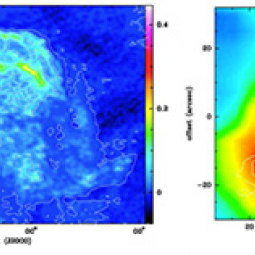CO emission observed by SOFIA/GREAT (12CO 11-10) and APEX (other lines) from supernova remnant W28.
Observations of supernova remnant W28 were made with the GREAT far-IR spectrometer during SOFIA’s Early Science program in 2011.
W28 is located in the inner part of the Milky Way Galaxy, near a large star-forming complex with HII regions including the well-known Trifid Nebula (Messier 20). W28 is about six thousand light-year from Earth and the supernova remnant is estimated to be about 20,000 years old.
The W28 nebula is the result of material ejected at high speed from a supernova explosion colliding with nearby relatively dense interstellar clouds (10 4 particles per cm 3 ). The GREAT instrument obtained spectra of carbon monoxide ( 12 CO) high rotational lines (11-10), as shown in Figures 1 & 2. Those CO lines probe warm CO, tracing the passage of the supernova shock wave through relative dense interstellar material. The 12 CO (11-10) line shape measured by GREAT differs significantly from those of low rotational lines, but is similar to line shapes of another isotopic variety of CO, optically thin 13 CO (3-2).
A model involving a low-velocity C-type shock wave encountering a thin layer of warm CO can reproduce the observed CO data. The thin CO layer may be warmed by ambient cosmic ray ionization.
Detailed information can be found in Gusdorf et al. (2012, Astronomy & Astrophysics 542, L19) .

